SUBARU LEGACY 2008 4.G Owners Manual
Manufacturer: SUBARU, Model Year: 2008, Model line: LEGACY, Model: SUBARU LEGACY 2008 4.GPages: 444, PDF Size: 14.1 MB
Page 111 of 444

2-22Keys and doors
To open the passengers ’windows, push
the appropriate switch down and hold it
until the window reaches the desiredposition.
To close the window, pull the switch up
and hold it until it reaches the desiredposition. !
Locking the passengers ’windows
To lock the passengers ’windows, push
the lock switch. When the lock switch is in
the “LOCK ”position, the passengers ’
windows cannot be opened or closed.
Press the switch again to cancel the passengers ’window locking. !
Passengers ’side switchesFront passenger ’s window switch
1) Open
2) Close
To open the window, push the switch
down and hold it until the window reaches
the desired position.
Page 112 of 444
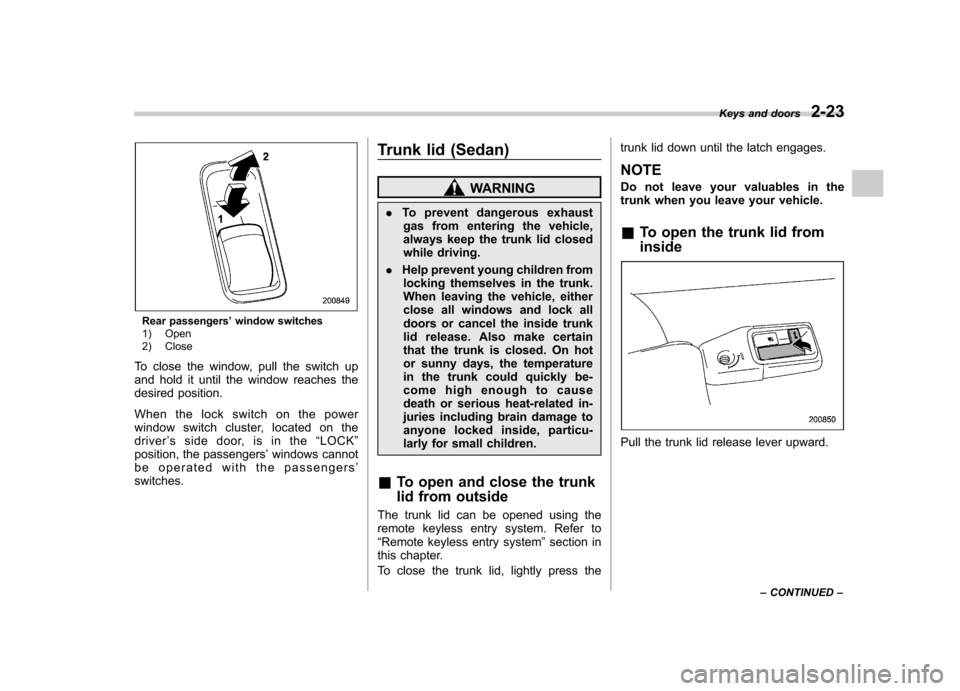
Rear passengers’window switches
1) Open
2) Close
To close the window, pull the switch up
and hold it until the window reaches the
desired position.
When the lock switch on the power
window switch cluster, located on thedriver ’s side door, is in the “LOCK ”
position, the passengers ’windows cannot
be operated with the passengers ’
switches. Trunk lid (Sedan)
WARNING
. To prevent dangerous exhaust
gas from entering the vehicle,
always keep the trunk lid closed
while driving.
. Help prevent young children from
locking themselves in the trunk.
When leaving the vehicle, either
close all windows and lock all
doors or cancel the inside trunk
lid release. Also make certain
that the trunk is closed. On hot
or sunny days, the temperature
in the trunk could quickly be-
come high enough to cause
death or serious heat-related in-
juries including brain damage to
anyone locked inside, particu-
larly for small children.
& To open and close the trunk
lid from outside
The trunk lid can be opened using the
remote keyless entry system. Refer to“ Remote keyless entry system ”section in
this chapter.
To close the trunk lid, lightly press the trunk lid down until the latch engages. NOTE
Do not leave your valuables in the
trunk when you leave your vehicle. &
To open the trunk lid from inside
Pull the trunk lid release lever upward. Keys and doors
2-23
– CONTINUED –
Page 113 of 444
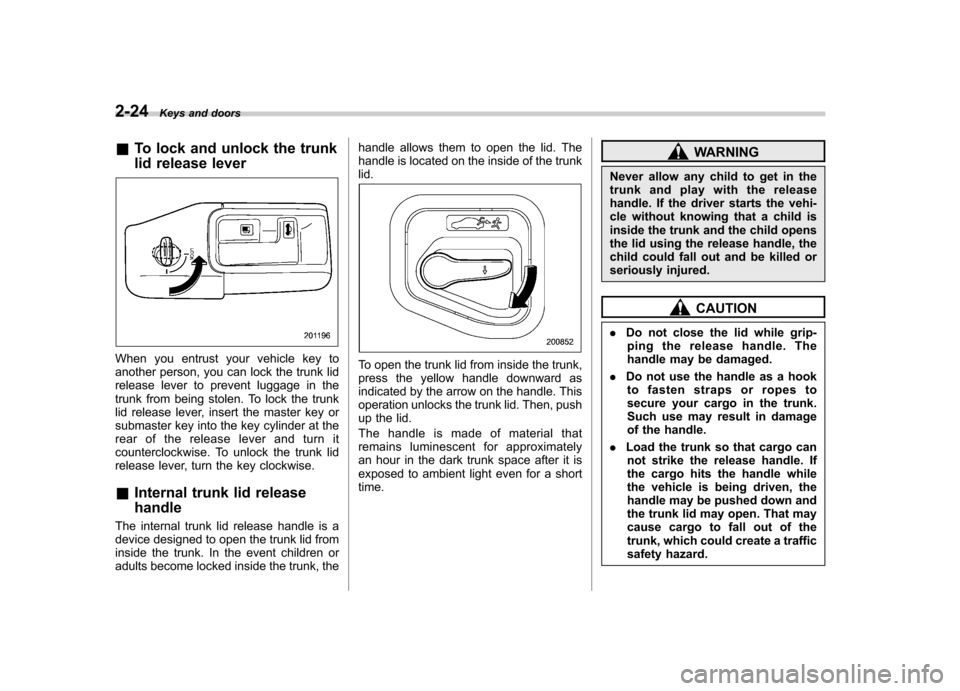
2-24Keys and doors
&To lock and unlock the trunk
lid release lever
When you entrust your vehicle key to
another person, you can lock the trunk lid
release lever to prevent luggage in the
trunk from being stolen. To lock the trunk
lid release lever, insert the master key or
submaster key into the key cylinder at the
rear of the release lever and turn it
counterclockwise. To unlock the trunk lid
release lever, turn the key clockwise. &Internal trunk lid release handle
The internal trunk lid release handle is a
device designed to open the trunk lid from
inside the trunk. In the event children or
adults become locked inside the trunk, the handle allows them to open the lid. The
handle is located on the inside of the trunklid.To open the trunk lid from inside the trunk,
press the yellow handle downward as
indicated by the arrow on the handle. This
operation unlocks the trunk lid. Then, push
up the lid.
The handle is made of material that
remains luminescent for approximately
an hour in the dark trunk space after it is
exposed to ambient light even for a shorttime.
WARNING
Never allow any child to get in the
trunk and play with the release
handle. If the driver starts the vehi-
cle without knowing that a child is
inside the trunk and the child opens
the lid using the release handle, the
child could fall out and be killed or
seriously injured.
CAUTION
. Do not close the lid while grip-
ping the release handle. The
handle may be damaged.
. Do not use the handle as a hook
to fasten straps or ropes to
secure your cargo in the trunk.
Such use may result in damage
of the handle.
. Load the trunk so that cargo can
not strike the release handle. If
the cargo hits the handle while
the vehicle is being driven, the
handle may be pushed down and
the trunk lid may open. That may
cause cargo to fall out of the
trunk, which could create a traffic
safety hazard.
Page 114 of 444
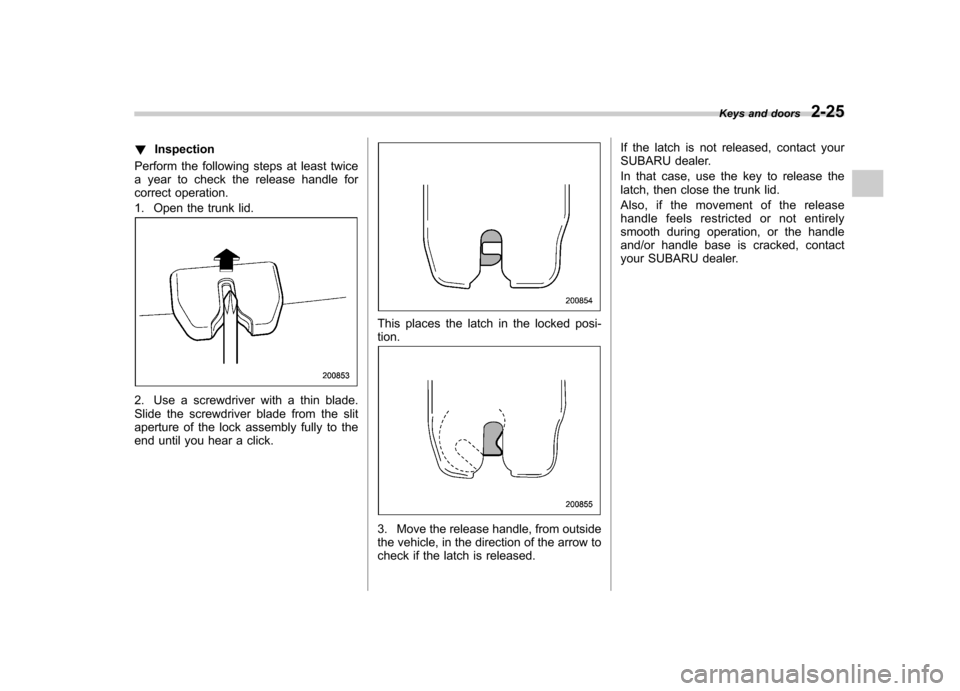
!Inspection
Perform the following steps at least twice
a year to check the release handle for
correct operation.
1. Open the trunk lid.
2. Use a screwdriver with a thin blade.
Slide the screwdriver blade from the slit
aperture of the lock assembly fully to the
end until you hear a click.
This places the latch in the locked posi- tion.
3. Move the release handle, from outside
the vehicle, in the direction of the arrow to
check if the latch is released. If the latch is not released, contact your
SUBARU dealer.
In that case, use the key to release the
latch, then close the trunk lid.
Also, if the movement of the release
handle feels restricted or not entirely
smooth during operation, or the handle
and/or handle base is cracked, contact
your SUBARU dealer.
Keys and doors
2-25
Page 115 of 444
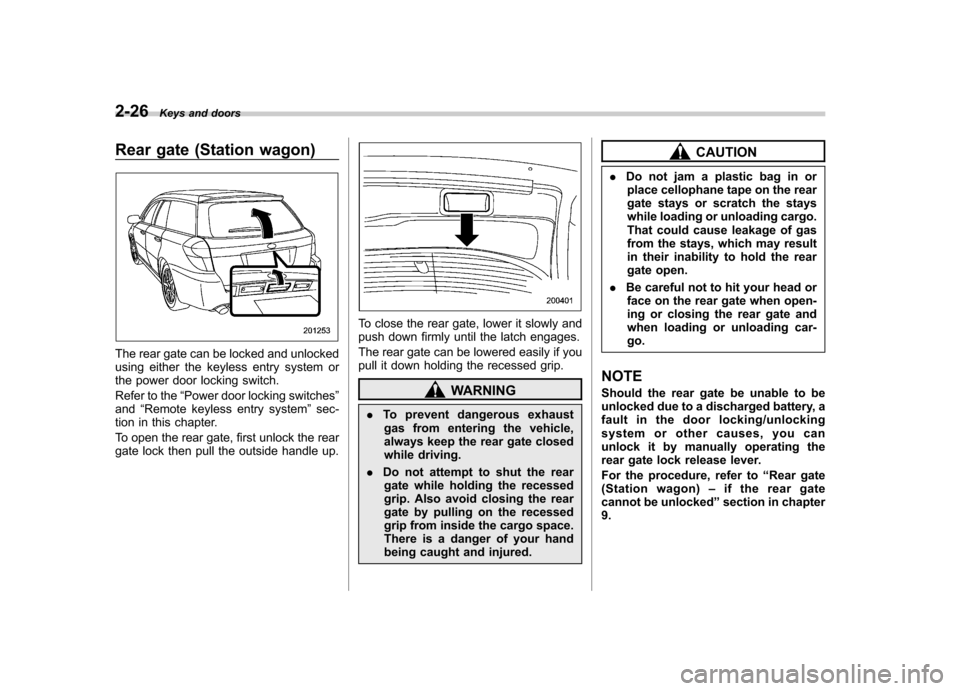
2-26Keys and doors
Rear gate (Station wagon)
The rear gate can be locked and unlocked
using either the keyless entry system or
the power door locking switch.
Refer to the “Power door locking switches ”
and “Remote keyless entry system ”sec-
tion in this chapter.
To open the rear gate, first unlock the rear
gate lock then pull the outside handle up.
To close the rear gate, lower it slowly and
push down firmly until the latch engages.
The rear gate can be lowered easily if you
pull it down holding the recessed grip.
WARNING
. To prevent dangerous exhaust
gas from entering the vehicle,
always keep the rear gate closed
while driving.
. Do not attempt to shut the rear
gate while holding the recessed
grip. Also avoid closing the rear
gate by pulling on the recessed
grip from inside the cargo space.
There is a danger of your hand
being caught and injured.
CAUTION
. Do not jam a plastic bag in or
place cellophane tape on the rear
gate stays or scratch the stays
while loading or unloading cargo.
That could cause leakage of gas
from the stays, which may result
in their inability to hold the rear
gate open.
. Be careful not to hit your head or
face on the rear gate when open-
ing or closing the rear gate and
when loading or unloading car-go.
NOTE
Should the rear gate be unable to be
unlocked due to a discharged battery, a
fault in the door locking/unlocking
system or other causes, you can
unlock it by manually operating the
rear gate lock release lever.
For the procedure, refer to “Rear gate
(Station wagon) –if the rear gate
cannot be unlocked ”section in chapter
9.
Page 116 of 444
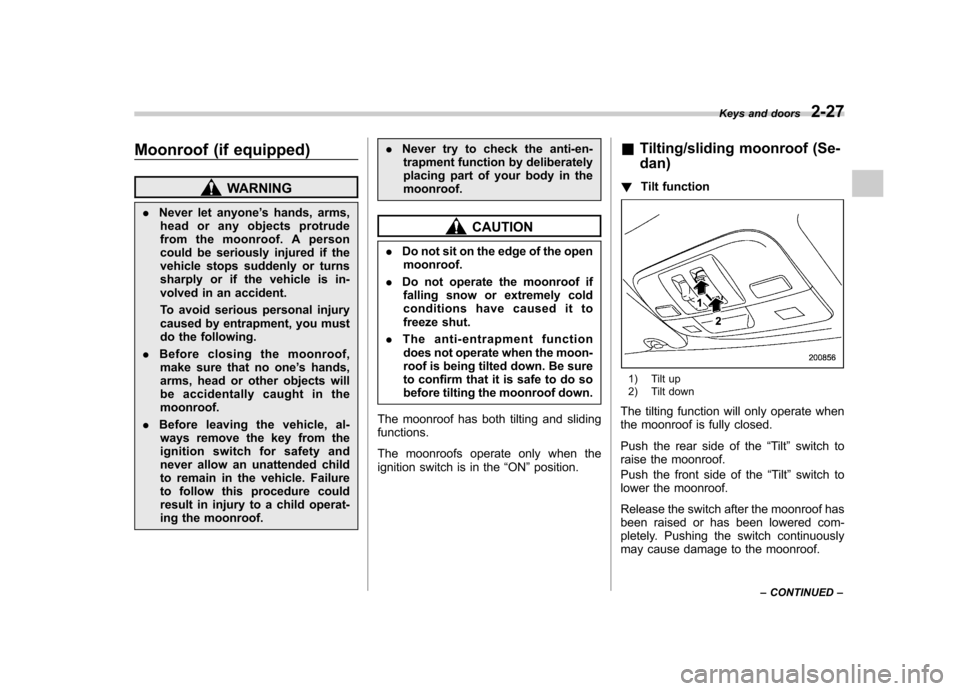
Moonroof (if equipped)
WARNING
. Never let anyone ’s hands, arms,
head or any objects protrude
from the moonroof. A person
could be seriously injured if the
vehicle stops suddenly or turns
sharply or if the vehicle is in-
volved in an accident.
To avoid serious personal injury
caused by entrapment, you must
do the following.
. Before closing the moonroof,
make sure that no one ’s hands,
arms, head or other objects will
be accidentally caught in themoonroof.
. Before leaving the vehicle, al-
ways remove the key from the
ignition switch for safety and
never allow an unattended child
to remain in the vehicle. Failure
to follow this procedure could
result in injury to a child operat-
ing the moonroof. .
Never try to check the anti-en-
trapment function by deliberately
placing part of your body in themoonroof.
CAUTION
. Do not sit on the edge of the open
moonroof.
. Do not operate the moonroof if
falling snow or extremely cold
conditions have caused it to
freeze shut.
. The anti-entrapment function
does not operate when the moon-
roof is being tilted down. Be sure
to confirm that it is safe to do so
before tilting the moonroof down.
The moonroof has both tilting and slidingfunctions.
The moonroofs operate only when the
ignition switch is in the “ON ”position. &
Tilting/sliding moonroof (Se- dan)
! Tilt function
1) Tilt up
2) Tilt down
The tilting function will only operate when
the moonroof is fully closed.
Push the rear side of the “Tilt ”switch to
raise the moonroof.
Push the front side of the “Tilt ”switch to
lower the moonroof.
Release the switch after the moonroof has
been raised or has been lowered com-
pletely. Pushing the switch continuously
may cause damage to the moonroof. Keys and doors
2-27
– CONTINUED –
Page 117 of 444
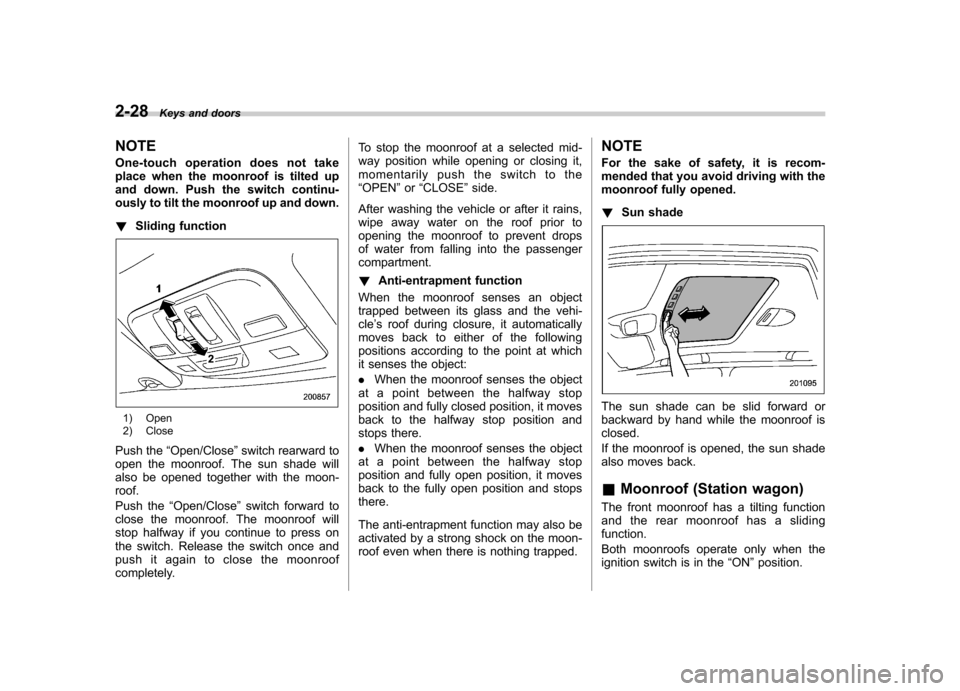
2-28Keys and doors
NOTE
One-touch operation does not take
place when the moonroof is tilted up
and down. Push the switch continu-
ously to tilt the moonroof up and down. ! Sliding function
1) Open
2) Close
Push the “Open/Close ”switch rearward to
open the moonroof. The sun shade will
also be opened together with the moon-roof.
Push the “Open/Close ”switch forward to
close the moonroof. The moonroof will
stop halfway if you continue to press on
the switch. Release the switch once and
push it again to close the moonroof
completely. To stop the moonroof at a selected mid-
way position while opening or closing it,
momentarily push the switch to the“
OPEN ”or “CLOSE ”side.
After washing the vehicle or after it rains,
wipe away water on the roof prior to
opening the moonroof to prevent drops
of water from falling into the passengercompartment. ! Anti-entrapment function
When the moonroof senses an object
trapped between its glass and the vehi- cle ’s roof during closure, it automatically
moves back to either of the following
positions according to the point at which
it senses the object: . When the moonroof senses the object
at a point between the halfway stop
position and fully closed position, it moves
back to the halfway stop position and
stops there. . When the moonroof senses the object
at a point between the halfway stop
position and fully open position, it moves
back to the fully open position and stopsthere.
The anti-entrapment function may also be
activated by a strong shock on the moon-
roof even when there is nothing trapped. NOTE
For the sake of safety, it is recom-
mended that you avoid driving with the
moonroof fully opened. !
Sun shadeThe sun shade can be slid forward or
backward by hand while the moonroof isclosed.
If the moonroof is opened, the sun shade
also moves back. &Moonroof (Station wagon)
The front moonroof has a tilting function
and the rear moonroof has a slidingfunction.
Both moonroofs operate only when the
ignition switch is in the “ON ”position.
Page 118 of 444

!Tilting moonroof
1) Open
2) Close
To tilt up the front moonroof, open the sun
shade and pull the switch to the “OPEN ”
side.
To tilt down the front moonroof, push the
switch to the “CLOSE ”side, then quickly
release it. If you wish to stop the tilting-
down motion of the front moonroof part-
way, either pull the switch to the “OPEN ”
side or push it to the “CLOSE ”side. !
Sliding moonroof1) Open
2) Close
To fully open the rear moonroof, tilt up the
front moonroof then pull the switch to the“ OPEN ”side and quickly release it. The
rear moonroof will stop at a position
approximately 6.7 in (17 cm) from its fully
closed position.
After confirming safety, pull the switch to the “OPEN ”side again and quickly release
it. The rear moonroof will open to its fully
open position. To stop the rear moonroof
at some selected mid-way point while it is
moving toward its fully open position,
momentarily push the switch to the“ CLOSE ”or “OPEN ”side.
To fully close the rear moonroof, push the switch to the
“CLOSE ”side then quickly
release it.
The rear moonroof will stop at a position
approximately 5.9 in (15 cm) before its
fully closed position. After confirming
safety, pull the switch to the “CLOSE ”
side again and quickly release it. The rear
moonroof will fully close. The front moon-
roof can then be fully closed. ! Anti-entrapment function
When the moonroof senses an object
trapped between its glass and during
closure, it automatically moves back by
5.9 in (15 cm) from that point and then
stops. The anti-entrapment function may
also be activated by a strong shock on the
moonroof even when there is nothingtrapped.
NOTE . For the sake of safety, it is recom-
mended that you avoid driving with the
moonroof fully opened.. Driving with the moonroof fully open
can cause an annoying sound to gen-
erate at high speeds. If such a condi-
tion has been encountered, use the
moonroof at the initial stop position of
6.7 in (17 cm). Keys and doors
2-29
– CONTINUED –
Page 119 of 444

2-30Keys and doors
! Sun shade
The sun shade can be slid forward or
backward by hand while the moonroof isclosed.
If the moonroof is opened, the sun shade
also moves back.
Page 120 of 444
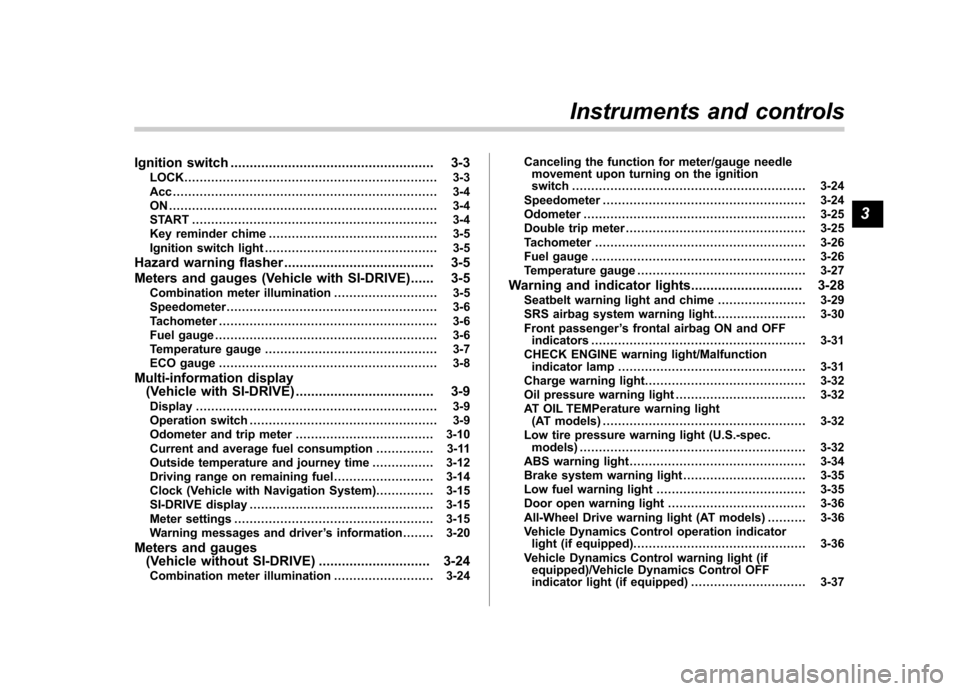
Ignition switch..................................................... 3-3
LOCK .................................................................. 3-3
Acc..................................................................... 3-4
ON...................................................................... 3-4
START ................................................................ 3-4
Key reminder chime ............................................ 3-5
Ignition switch light ............................................. 3-5
Hazard warning flasher ....................................... 3-5
Meters and gauges (Vehicle with SI-DRIVE) ...... 3-5
Combination meter illumination ........................... 3-5
Speedometer ....................................................... 3-6
Tachometer ......................................................... 3-6
Fuel gauge .......................................................... 3-6
Temperature gauge ............................................. 3-7
ECO gauge ......................................................... 3-8
Multi-information display (Vehicle with SI-DRIVE) .................................... 3-9
Display ............................................................... 3-9
Operation switch ................................................. 3-9
Odometer and trip meter .................................... 3-10
Current and average fuel consumption ............... 3-11
Outside temperature and journey time ................ 3-12
Driving range on remaining fuel .......................... 3-14
Clock (Vehicle with Navigation System) ............... 3-15
SI-DRIVE display ................................................ 3-15
Meter settings .................................................... 3-15
Warning messages and driver ’s information ........ 3-20
Meters and gauges (Vehicle without SI-DRIVE) ............................. 3-24
Combination meter illumination .......................... 3-24 Canceling the function for meter/gauge needle
movement upon turning on the ignition switch ............................................................. 3-24
Speedometer ..................................................... 3-24
Odometer .......................................................... 3-25
Double trip meter ............................................... 3-25
Tachometer ....................................................... 3-26
Fuel gauge ........................................................ 3-26
Temperature gauge ............................................ 3-27
Warning and indicator lights ............................. 3-28
Seatbelt warning light and chime ....................... 3-29
SRS airbag system warning light ........................ 3-30
Front passenger ’s frontal airbag ON and OFF
indicators ........................................................ 3-31
CHECK ENGINE warning light/Malfunction indicator lamp ................................................. 3-31
Charge warning light .......................................... 3-32
Oil pressure warning light .................................. 3-32
AT OIL TEMPerature warning light (AT models) ..................................................... 3-32
Low tire pressure warning light (U.S.-spec. models) ........................................................... 3-32
ABS warning light .............................................. 3-34
Brake system warning light ................................ 3-35
Low fuel warning light ....................................... 3-35
Door open warning light .................................... 3-36
All-Wheel Drive warning light (AT models) ..... ..... 3-36
Vehicle Dynamics Control operation indicator light (if equipped). ............................................ 3-36
Vehicle Dynamics Control warning light (if equipped)/Vehicle Dynamics Control OFF
indicator light (if equipped) .............................. 3-37
Instruments and controls
3